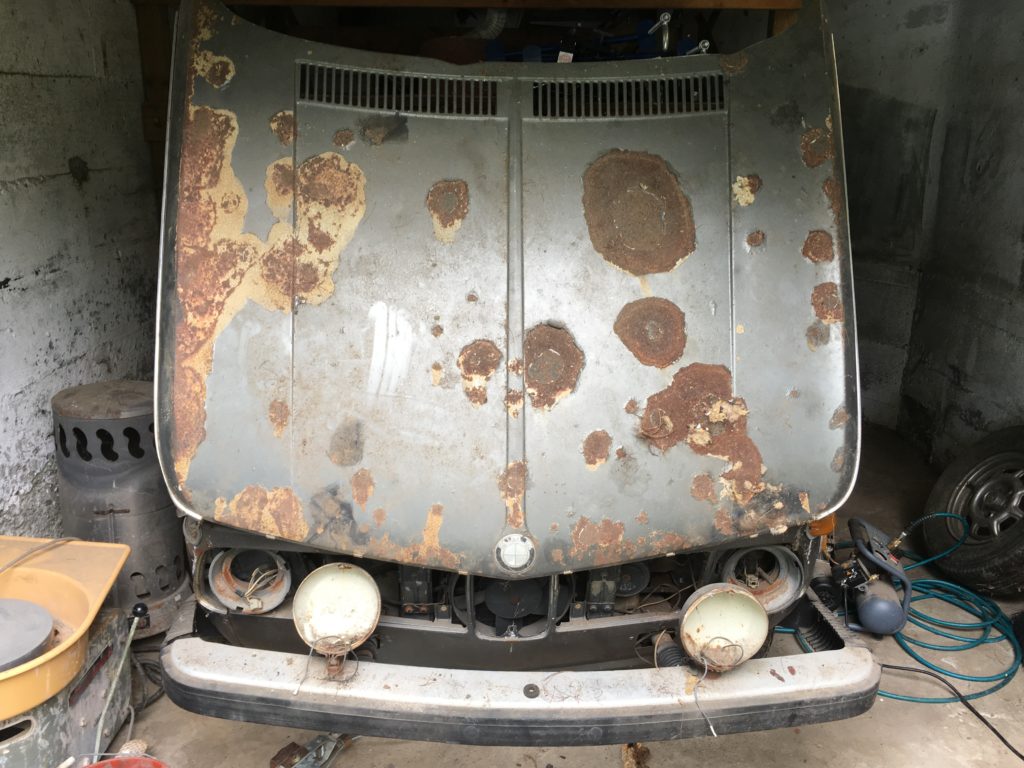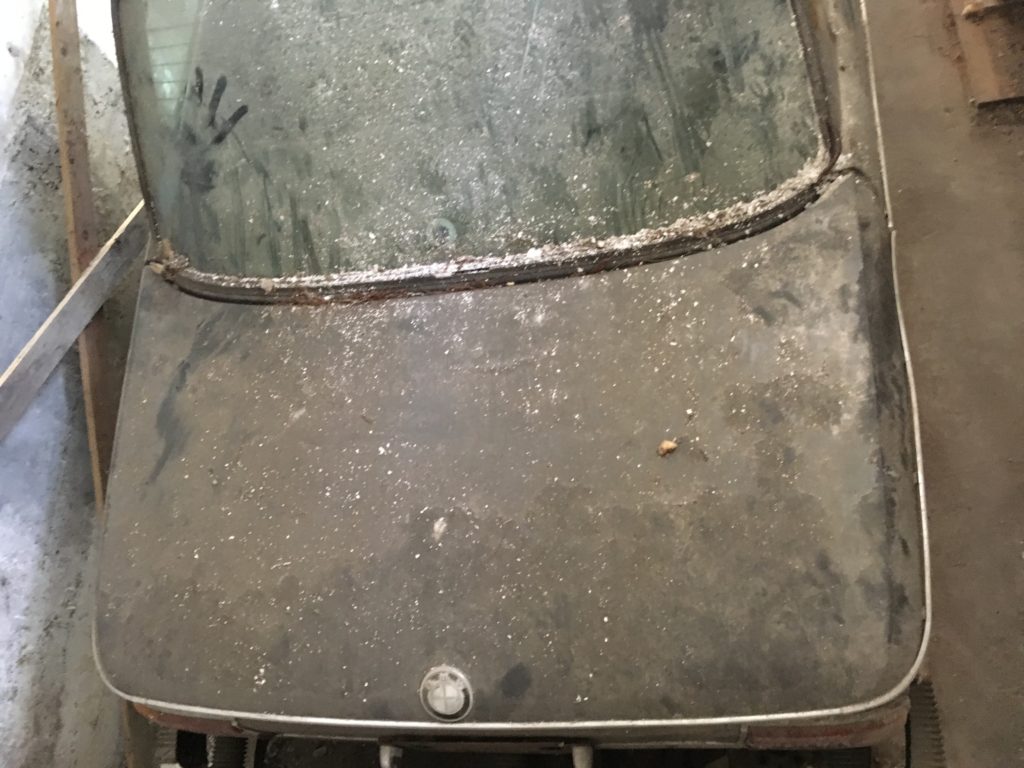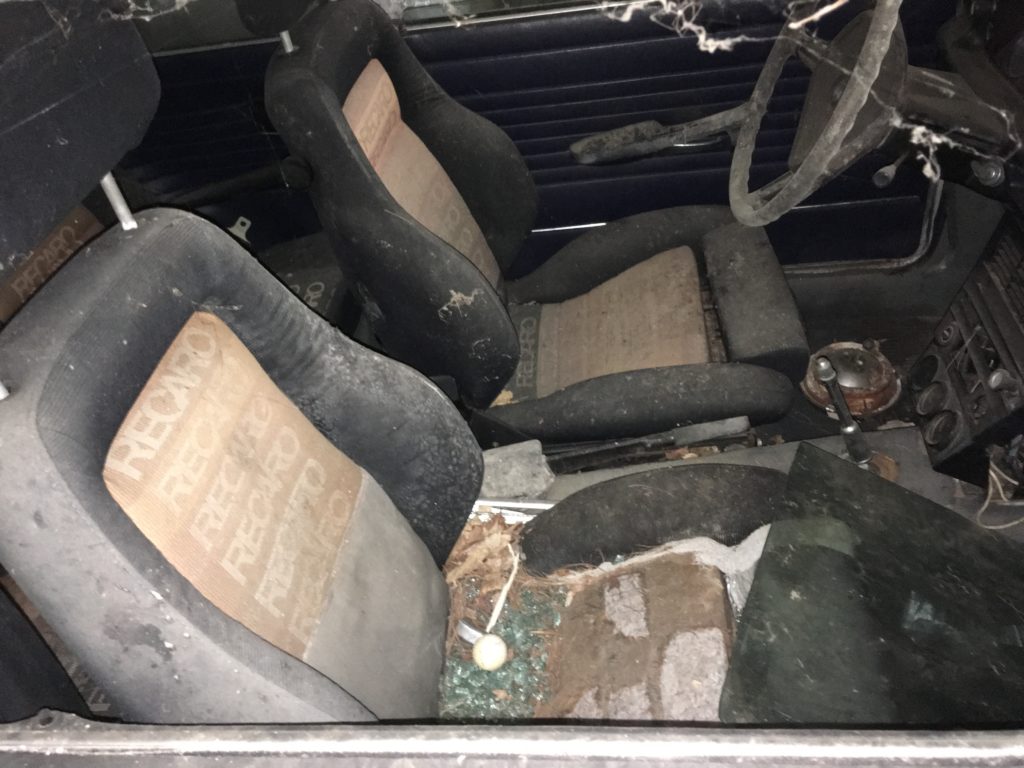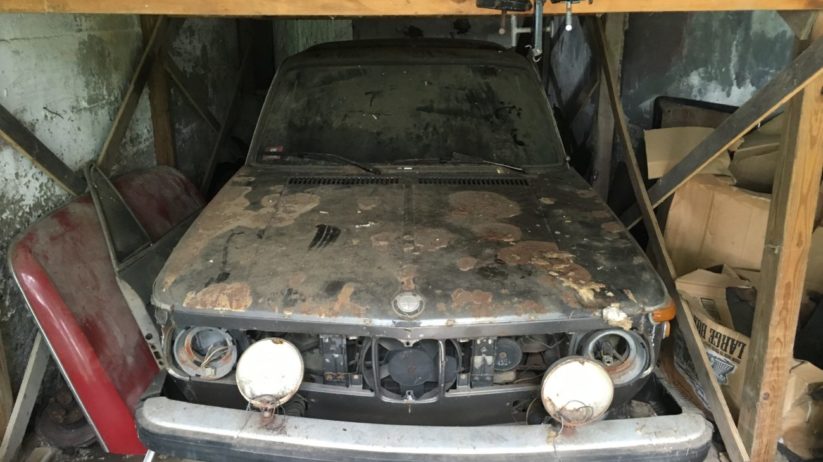I am a man to whom context is important; this is why some of my stories have a long arc. This one goes back 34 years, and it’s still unfolding. And the new part of the arc is likely to be like a roller coaster, so strap in.
I am buying Bertha back.
Wait, what? As long-time readers of my Roundel column and those who’ve read my first book, Memoirs of a Hack Mechanic, know, I bought Bertha, a ’75 2002, in the spring of 1984 when Maire Anne and I were still living in Austin but knew that we would be returning soon to Boston. The car had bridge-abutment bumpers that I thought might stand a chance in the demolition derby of Boston traffic and parking. It also had working air-conditioning.
Bertha’s name originated from those bumpers, since with them, she was anything but dainty. In addition, the car’s gray paint looked like it had chunks of cement mixed into it. Bertha was never pretty, but she always looked purposeful.
At the time, I was driving a Malaga ’73 2002 whose engine I’d just rebuilt. So when I bought Bertha, I swapped engines, putting the newly-rebuilt one in the car I was keeping, and selling the ’73. I now marvel at the fact that I sold a rust-free Texas small-bumpered roundie and kept not only a big-bumpered 2002, but arguably the worst big-bumpered 2002 (a ’75 with horrible levels of emission controls), but the reasons made sense to me at the time. And yes, I threw the thermal reactor in the trash when I swapped engines.
Maire Anne and I moved Bertha up to Boston with us in the summer of ’84. After our wedding in August, we drove off in Bertha, the car covered in shaving cream and toilet paper, with cans trailing from her massive rear bumper.

Our friends did a number on Bertha before Maire Anne and I drove off in it from our wedding.
My friend Alex enters the picture at this time in (literally) a funny way. When he is asked how we met, Alex says, “Rob drove into my repair shop and asked if he could borrow a door.”
This is absolutely true: I’d damaged Bertha’s driver’s door backing the car out my mother’s garage. I’d ordered another door, but when it arrived, it, too, was damaged. This was a problem, as Maire Anne and I had a honeymoon road trip planned, and I’d already taken off the original door. The vendor promised me a replacement, but it wouldn’t arrive before we needed to leave.
There was a repair shop across the street from my mother’s house in Brighton called McCray’s. I drove Bertha inside. A cheerful young man greeted me and asked, “Can I help you?”
I said probably the last thing he ever imaged: “Yes. I’d like to borrow a door.”
“You want to… borrow a door?”
I explained what had happened, and how I had another door on the way, but it wouldn’t arrive in time, thus justifying my entirely rational request to borrow a door. But Alex did not have a door he could loan me, something I remind him of when he tells the story lest he portray himself as more helpful in my door-related quest than he actually was. But it was, as they say, the start of a beautiful friendship; we spent years being 2002 buddies, wrenching together, and helping each other drive home and part-out cars.
Regarding my urgent need for a door: I wound up putting the old door back on Bertha for our road trip, and then, when the new door arrived, priming and installing it. I thought I’d soon get the whole car painted, so I never bothered to put the trim back on the primered door.
Bertha became the vessel for my automotive dreams and the repository of a good amount of my disposable income. She underwent a kind of transmogrification. I found a rotted 2002ti—yes, you read it right—with a cratered engine. I stripped it and put the big brake booster, master cylinder, struts, big calipers, and rotors into Bertha. Then I found a rusty ’72 tii, pulled its engine, rebuilt it to Euro specs, combined it with Bertha’s carbs, and installed it.
By the time I was done, Bertha read like she’d had a shopping spree in a 1988 issue of Roundel magazine: 10:1 pistons, dual Weber 40DCOEs, 300-degree cam, Metric Mechanic gearbox, Koni suspension, Recaro interior (with that striped orange fabric that said Recaro on each of the seats like twelve times), Yokohama A008s, auxiliary gauge cluster, Wink mirror, killer stereo. When I took the car into Beaconwood Motors (who advertised on the back cover of Roundel for years) to have the Webers jetted, they said that it was one of the fastest 2002s they’d ever had in the shop. Perhaps transmogrification has to precede resurrection.
Not long after the engine rebuild, Bertha’s battery light came on. I expected to find that the fan belt had snapped. When I opened the hood, I was stunned to see that the belt was still there, but it was stationary—which was odd, to say the least, because the engine was running. What the—?!
It turned out that the Woodruff key holding the hub and crank pulley in place on the crankshaft had sheared off, and the hub was freewheeling on the front of the crank, ruining it. I had to pull the engine and replace the crank. Thus Bertha was the only car I’ve ever owned in which I rebuilt the engine, or at least portions of it, three times—within a three-year period.

Bertha takes the ferry to Digby, Nova Scotia, in 1988.
I daily-drove the car for about seven years, swapping it for winter beaters when the roads got ugly. I used it at Boston CCA Chapter-sponsored track days back when I used to do such things. In 1988, Maire Anne and I took Bertha up to Cape Breton, Nova Scotia—our last road trip together before the kids were born. When we came back into the United States, customs agents at the border looked very closely at the Webers and the primer-painted door, convinced that I was trying to illegally bring in a gray-market car by deleting the tags that were affixed to the original door.
And then, along came the coupe: my 1973 3.0CSi. Maire Anne and I were still living at my mother’s house in Brighton, which had a two-car garage that housed both the coupe and Bertha, but as Child #3—human child, not car child—was approaching, we needed more room. The house we bought in Newton in 1991 had more room for the family, but ironically, less space for the cars. I’d just had the 3.0 painted, so there was no question that it had dibs on the new house’s single-car garage. This meant that Bertha would need to sit outside, a far-from-ideal situation.
Around this time, Alex got married. He and his wife were planning on taking Alex’s 2002 on a big western road trip, doing the Grand Circle of national parks, but the car needed some repairs—and as their departure date neared, it wasn’t ready. I offered them use of Bertha—a well-sorted car with air-conditioning—as a wedding present.
When they got back from their trip six weeks later, the couple had bonded with Bertha. We talked about my impending lack of garage space, and over the next few weeks, a deal was struck: Alex bought Bertha, whose driver’s door was still in primer. He had big plans for the car, including finally stripping off its cement-like finish, repainting it, and installing Euro bumpers. (Alex was an early fan of the Euro “small-bumper squarie” look before it became cool). I thought I’d engineered a smooth transition that would ensure Bertha’s safe future.
It’s significant (at least to me) to note that not only was Bertha the 2002 that I owned when I returned to Boston in 1984 and joined the BMW CCA, it was also my last 2002 for many years. Since the Newton house’s one-car garage had to shelter the 3.0CSi, any other car I owned was required to sit outside. A parade of E12s, E28s, E30s, and E36s came and went as daily drivers, but it wasn’t until my new garage was built in 2005 that I bought another 2002. So Bertha’s sale, although I didn’t know it at the time, really was a bellwether event.
Unfortunately, after Alex bought Bertha, her story goes downhill. Alex got out of the BMW parts business and became a building contractor. His garage became occupied by tools and supplies, so Bertha sat on the street. This was the late ’80s and early ’90s, when BMW stood for “Break My Window.” The car was stolen and vandalized. It was recovered, and I fixed it for Alex after we towed it back to my house with a rope (ah, youth). As part of that work, Alex treated himself to a five-speed overdrive transmission, which I installed for him. But soon after, Bertha was stolen again, and came back running badly enough that Alex suspected engine damage, like a floated valve from an over-revved motor.
In mid-1992, Alex rolled Bertha into an unused and difficult-to-access garage located in the back of his neighbor’s house.
Alex and I remained close. He built the kitchen and third-floor addition onto our house in 1995; he built my new garage in 2005. But with his busy schedule, he never got back to Bertha. She just sat in his neighbor’s garage.
Busy people with multiple projects deal with them in a variety of ways. I am, above most things, a very practical person, with a good track record of not biting off more than I can chew (*coughLotuscough*). Alex, on the other hand, is a visionary who can picture in his head just how he wants a finished project to look, but doesn’t always get the project across the finish line. I’d ask him about Bertha, and he’d say that he didn’t want to deal with her until he was able to do the restoration the way he wanted. I’d say, “Or, we could just get her running again.” Two ways of looking at things. Vive la différence.
But as decades passed, the car became almost an open wound for Alex. It was no longer just a car; it had turned into a poster child for his tendency to accumulate projects and not finish them. When I’d ask him about Bertha, he’d wince.
People often pine for their old cars and search for them. I, on the other hand, knew where Bertha been sitting since 1991—just five miles from my house—and wasn’t pining for her in the least. I didn’t need her back; it was more like curiosity combined with a sense of paternal responsibility, and a smattering of the perennial possibility-sniffing that a serial flipper like me lives and breathes.
It was like a barn find where I was the only one who knew where the barn was.
About a month ago, a number of factors made me turn my thoughts back toward Bertha. One was that CCA member Daniel Sherron contacted me asking for advice about the steps in starting a long-dormant car. I spoke with him, and it turned out he was buying back a highly-modified Bertha-like 2002 he’d sold to a friend in 1992. The car was reportedly still an unfinished project, but was in great shape. “I feel like a genius,” Daniel said. “It’s like I got 26 years of clean storage for free.”
The other dynamic was that, having just sold the Black Shark (the ’85 635CSi), I had money burning a hole in my pocket.
I looked at a couple of needy 2002s: One ran but had so many issues that I couldn’t see the upside of it as a flipper. The other was a basket-case tii tribute car. Both had rotted frame rails. I thought, you know, if I saw Bertha, with her list of parts, advertised on Craigslist, even dead and in rough shape, I’d drop everything and go look.
So out of the blue, I sent a very simple text to Alex. It said, “I’ll give you XXX in cash for Bertha. Do it. Do It! DO IT!”
Two days later, he responded, “Hmm.…”
Two days after that, we chatted. It turned out that by chance I’d caught Alex in a moment of reflection on his unfinished projects. We talked about life, time, and the balance between pursuing one’s passion versus simplification and a sense of peace. “No pressure regarding Bertha,” I said. “It’s just an idea.”
“No,” said Alex, “It’s time for me to let her go.” By the end of the phone call, I’d made a verbal agreement to buy Bertha back.
I told Maire Anne. If ever my wife deserved the Best Wife Ever title, it was at this moment: She said, “Oh, I loved that car! So many good memories! I was thinking of contacting Alex and buying it back for you as a 60th birthday present!”
Best. Wife. Ever.
Alex warned me, though, that due to a combination of neglect and vandalism, Bertha’s condition had deteriorated from rough to basket case. In addition, he said, the car was surrounded by boxes of old used 2002 parts that had also deteriorated and were falling in on the car, so extracting the car from the garage required dealing with the parts hoard. Finally, he said, it was going to be challenging getting Bertha out of the garage and up on the street, because the garage is in the back of the neighbor’s house, and that house used to share a driveway with the adjacent neighbor, but in the intervening years, the adjacent neighbor had built a fence, so to get the car onto the driveway and out to the street, a section of the fence would have to come down.
It was my turn to say, “Hmm.”
Last Saturday, I drove into Brighton to see my old car. I was shocked at how badly it had deteriorated. You know those sci-fi movies where aliens vomit acid? It looked like one of them had horked on the hood of the car. The headlights were missing, the passenger window had been smashed, glass littered the interior, there was evidence of rodent incursion everywhere—and by rodent I mean rat, judging by the size of the turds. I thought about Daniel Sherron’s comment about getting 26 years of clean storage for free; clearly I had not gotten in on that deal.

“A little the worse for wear” doesn’t begin to describe it.

A powdery residue from the plaster-and-cinder-block garage was everywhere.

The once-mint Recaro interior has been laid low by rodents, mold and mildew, and a shattered passenger-side window adds to the glitter.

Yes, those are rat turds sitting on the Weber’s air filters.
At this point, I must quote my own book: “I’m sure every car guy who ever found a cool car in a barn would give his eyeteeth to go back in time, find the owner, hand him a car cover, and beat the crap out of him until he agrees to go out to the barn and put the cover on the damn car.”
In this case, I knew the owner. Hell, he was standing right next to me.
After I got my wits about me, I donned the traditional Tyvek suit and sized the car up. Other than a yawning hole in the driver’s-side floor behind the pedal bucket, the car was actually still remarkably solid, with a little bubbling here and there but no other rust-through that I could find. The engine turned free. I grinned ear-to-ear when I saw the driver’s-side door still in primer. I stuck my head inside, expecting to be bowled over by lethal levels of rodent fumes, but the main smell was, instead, musty.

Driver’s door still in primer after 34 years? Check!
I picked the broken glass off the driver’s seat and sat in it. The ever-echoing Recaro seat still cradled my butt. The Wink mirror was still there. Even in ruins, it felt familiar.
There’s only one car I drove off from my wedding in. It’s this one. That’s worth something, right? Well, what would you do?
Bertha is coming home. She may look like an escapee from a Mad Max movie, but she is coming home.
In the very last chapter of Memoirs, I say that well-cared-for vintage cars are like a reverse of The Picture of Dorian Gray, the Oscar Wilde novel in which a gentleman has a portrait in his attic that becomes more horrible with every evil deed he commits, while his physical appearance remains unchanged. In contrast, pampered vintage cars stay forever young, while we, their owners, age; it’s like we’re their portraits in the attic.
With that in mind, I had an epiphany about Bertha. I turn 60 next month. Once I get her running and begin driving her around, horrifying purists and frightening children, someone may say, “Boy, that car looks like hell, but you look great!”
It’s the one bit of rationality I can apply to a purchase that otherwise makes absolutely no sense whatsoever.—Rob Siegel
Rob’s new recent book, Just Needs a Recharge: The Hack MechanicTM Guide to Vintage Air Conditioning, is available here on Amazon. Or you can order personally inscribed copies through Rob’s website: www.robsiegel.com.





















